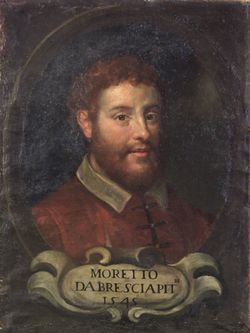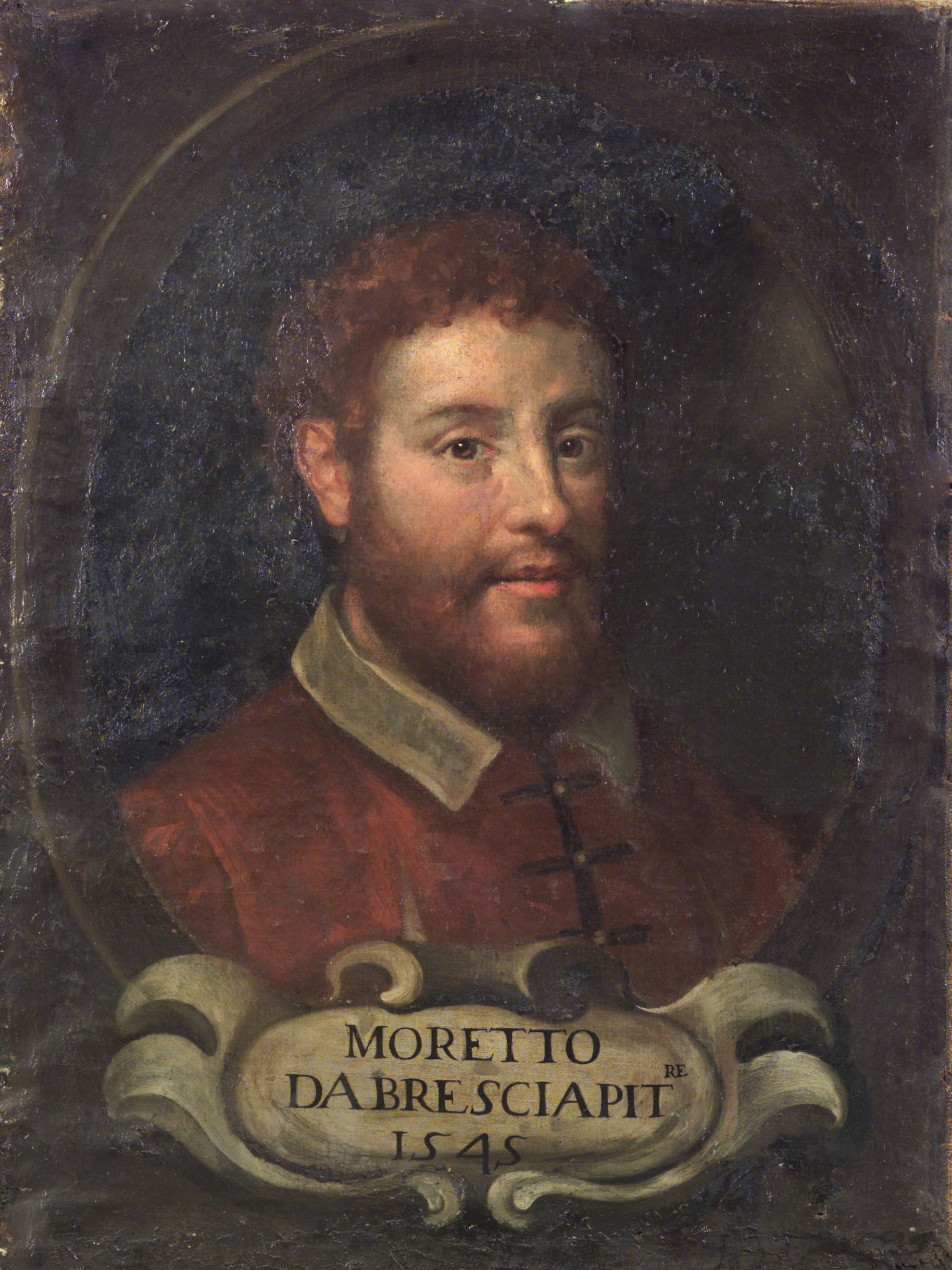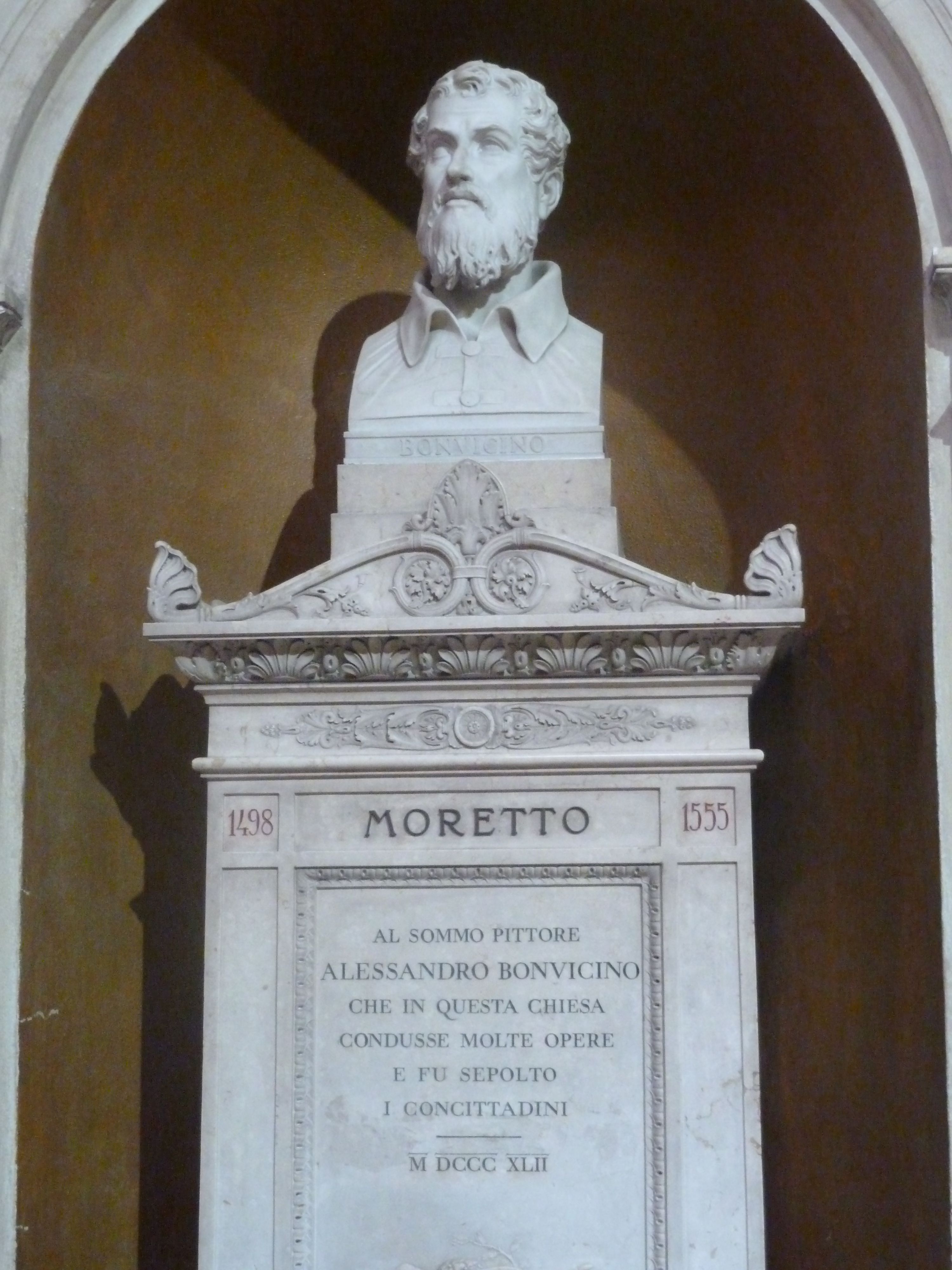Moretto da Brescia excelled more in sedate altarpieces than in narrative action, and more in oil painting than in fresco. In 1521, Moretto painted a fine trompe l'oeil and portrait fresco in a palace just outside of Brescia commissioned by Count Martinengo. This fresco painting depicts a whimsical, dreamy and pensive quality to portraits of the count's four daughters perched in an imaginative conjoined archway with an expansive landscape in the background with some identifiable topography (and some imaginative) of the environs of 16th century Brescia. This "eye-fooling" fresco radiates in different directions from what was a central anteroom of the palace. In 1521, he worked with Girolamo Romanino in the Cappella del Sacramento in the old cathedral of Brescia. He was active from 1522 to 1524 in Padua, and in later years active in Milan, Verona, Bergamo & Asola.
In Brescia, he completed a Five Virgin Martyrs and his masterpiece, the "Assumption of the Madonna" for the church of San Clemente (where it would become his final resting place). A "Coronation of the Madonna with four saints" (c. 1525) for the church of Santi Nazaro e Celso, a "St. Joseph" for Santa Maria della Grazie and a "St Nicholas of Bari" for Santa Maria de Miracoli.
Il Moretto's dated works extend from 1524 to 1554, but was already considered a master by his contemporaries as early as 1516. Moretto's pupil was the portrait-painter Giambattista Moroni. He also influenced Callisto Piazza (1500-1561) who went on to work in numerous locations across the region of Lombardy.
Moretto was buried in 1554 in the church of San Clemente. After his death, it was (unofficially) renamed by the locals as "The Temple of Moretto" (Tempio del Moretto), for his noteworthy career in the Renaissance, whose career went on to influence many painters and followers. His nickname was "The Raphael of Brescia" for the sublime qualities also found in the art of Raphael Sanzio (Urbino 1483- Rome 1520).
Moretto is represented in the following museums & collections: National Gallery, London; Metropolitan Museum of Art, New York; Hermitage, St. Petersburg; Kunsthistorisches Museum, Vienna; Staedel Museum, Frankfurt; Gallerie dell'Accademia, Venice; Pinacoteca Tosio Martinengo, Brescia (Annunciation); Pinacoteca Ambrosiana, Milan; National Gallery of Art, Washington; Louvre, Paris; Ashmolean Museum, Oxford; Museum of Fine Arts, Budapest, among others.
Moretto da Brescia excelled more in sedate altarpieces than in narrative action, and more in oil painting than in fresco. In 1521, Moretto painted a fine trompe l'oeil and portrait fresco in a palace just outside of Brescia commissioned by Count Martinengo. This fresco painting depicts a whimsical, dreamy and pensive quality to portraits of the count's four daughters perched in an imaginative conjoined archway with an expansive landscape in the background with some identifiable topography (and some imaginative) of the environs of 16th century Brescia. This "eye-fooling" fresco radiates in different directions from what was a central anteroom of the palace. In 1521, he worked with Girolamo Romanino in the Cappella del Sacramento in the old cathedral of Brescia. He was active from 1522 to 1524 in Padua, and in later years active in Milan, Verona, Bergamo & Asola.
In Brescia, he completed a Five Virgin Martyrs and his masterpiece, the "Assumption of the Madonna" for the church of San Clemente (where it would become his final resting place). A "Coronation of the Madonna with four saints" (c. 1525) for the church of Santi Nazaro e Celso, a "St. Joseph" for Santa Maria della Grazie and a "St Nicholas of Bari" for Santa Maria de Miracoli.
Il Moretto's dated works extend from 1524 to 1554, but was already considered a master by his contemporaries as early as 1516. Moretto's pupil was the portrait-painter Giambattista Moroni. He also influenced Callisto Piazza (1500-1561) who went on to work in numerous locations across the region of Lombardy.
Moretto was buried in 1554 in the church of San Clemente. After his death, it was (unofficially) renamed by the locals as "The Temple of Moretto" (Tempio del Moretto), for his noteworthy career in the Renaissance, whose career went on to influence many painters and followers. His nickname was "The Raphael of Brescia" for the sublime qualities also found in the art of Raphael Sanzio (Urbino 1483- Rome 1520).
Moretto is represented in the following museums & collections: National Gallery, London; Metropolitan Museum of Art, New York; Hermitage, St. Petersburg; Kunsthistorisches Museum, Vienna; Staedel Museum, Frankfurt; Gallerie dell'Accademia, Venice; Pinacoteca Tosio Martinengo, Brescia (Annunciation); Pinacoteca Ambrosiana, Milan; National Gallery of Art, Washington; Louvre, Paris; Ashmolean Museum, Oxford; Museum of Fine Arts, Budapest, among others.
Bio by: Moretto
Gravesite Details
Buried at Tempio Moretto in the church of San Clemente, in Brescia.
Advertisement
See more Bonvicino memorials in:
Advertisement



